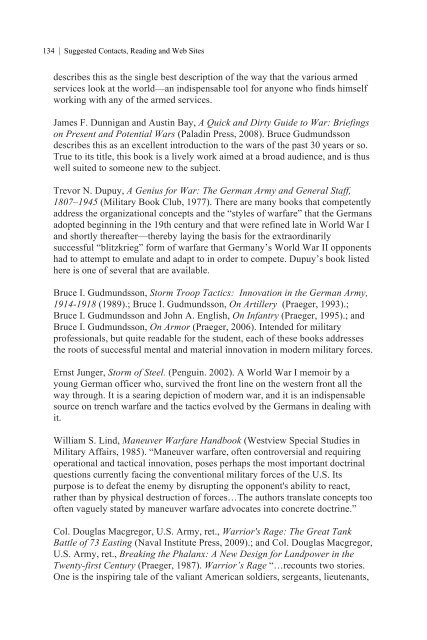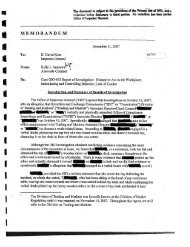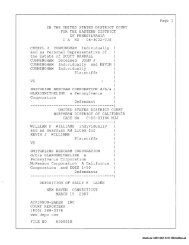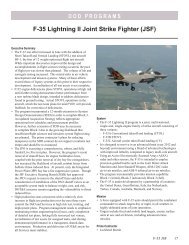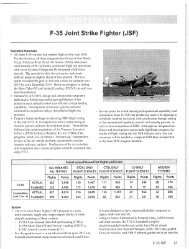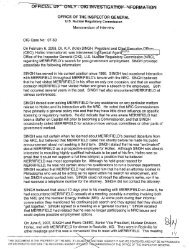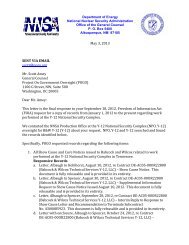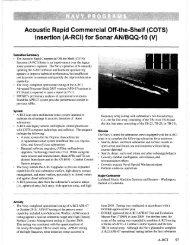The Pentagon Labyrinth
The Pentagon Labyrinth
The Pentagon Labyrinth
Create successful ePaper yourself
Turn your PDF publications into a flip-book with our unique Google optimized e-Paper software.
134 | Suggested Contacts, Reading and Web Sites<br />
describes this as the single best description of the way that the various armed<br />
services look at the world—an indispensable tool for anyone who finds himself<br />
working with any of the armed services.<br />
James F. Dunnigan and Austin Bay, A Quick and Dirty Guide to War: Briefings<br />
on Present and Potential Wars (Paladin Press, 2008). Bruce Gudmundsson<br />
describes this as an excellent introduction to the wars of the past 30 years or so.<br />
True to its title, this book is a lively work aimed at a broad audience, and is thus<br />
well suited to someone new to the subject.<br />
Trevor N. Dupuy, A Genius for War: <strong>The</strong> German Army and General Staff,<br />
1807–1945 (Military Book Club, 1977). <strong>The</strong>re are many books that competently<br />
address the organizational concepts and the “styles of warfare” that the Germans<br />
adopted beginning in the 19th century and that were refined late in World War I<br />
and shortly thereafter—thereby laying the basis for the extraordinarily<br />
successful “blitzkrieg” form of warfare that Germany’s World War II opponents<br />
had to attempt to emulate and adapt to in order to compete. Dupuy’s book listed<br />
here is one of several that are available.<br />
Bruce I. Gudmundsson, Storm Troop Tactics: Innovation in the German Army,<br />
1914-1918 (1989).; Bruce I. Gudmundsson, On Artillery (Praeger, 1993).;<br />
Bruce I. Gudmundsson and John A. English, On Infantry (Praeger, 1995).; and<br />
Bruce I. Gudmundsson, On Armor (Praeger, 2006). Intended for military<br />
professionals, but quite readable for the student, each of these books addresses<br />
the roots of successful mental and material innovation in modern military forces.<br />
Ernst Junger, Storm of Steel. (Penguin. 2002). A World War I memoir by a<br />
young German officer who, survived the front line on the western front all the<br />
way through. It is a searing depiction of modern war, and it is an indispensable<br />
source on trench warfare and the tactics evolved by the Germans in dealing with<br />
it.<br />
William S. Lind, Maneuver Warfare Handbook (Westview Special Studies in<br />
Military Affairs, 1985). “Maneuver warfare, often controversial and requiring<br />
operational and tactical innovation, poses perhaps the most important doctrinal<br />
questions currently facing the conventional military forces of the U.S. Its<br />
purpose is to defeat the enemy by disrupting the opponent's ability to react,<br />
rather than by physical destruction of forces…<strong>The</strong> authors translate concepts too<br />
often vaguely stated by maneuver warfare advocates into concrete doctrine.”<br />
Col. Douglas Macgregor, U.S. Army, ret., Warrior's Rage: <strong>The</strong> Great Tank<br />
Battle of 73 Easting (Naval Institute Press, 2009).; and Col. Douglas Macgregor,<br />
U.S. Army, ret., Breaking the Phalanx: A New Design for Landpower in the<br />
Twenty-first Century (Praeger, 1987). Warrior’s Rage “…recounts two stories.<br />
One is the inspiring tale of the valiant American soldiers, sergeants, lieutenants,


